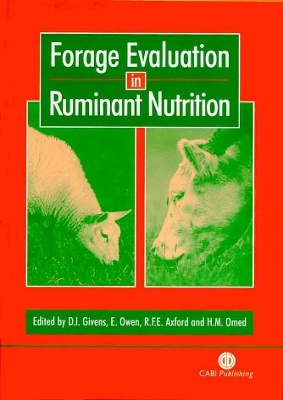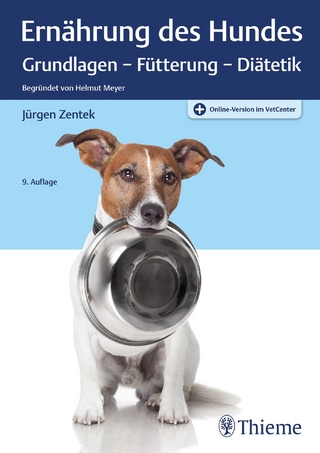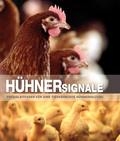
Forage Evaluation in Ruminant Nutrition
CABI Publishing (Verlag)
978-0-85199-344-7 (ISBN)
Current pressures to maximise the use of forages in ruminant diets have renewed interest in fast, inexpensive methods for the estimation of their nutritional value. As a result, a wide variety of biological and physiochemical procedures have recently been investigated for this purpose.This book is the single definitive reference volume on the current status of research in this areaCovers all forages eaten by ruminant animals
SECTION 1: THE IMPORTANCE OF FORAGE EVALUATION FOR HUMANS AND ANIMALS 1: Forages and their role in animal systems, R J Wilkins, Institute of Grassland and Environmental Research, UK 2: Forage evaluation for efficient ruminant livestock production, D E Beever and FL Mould, CEDAR (Centre for Dairy Research), The University of Reading, UK 3: Intake of forages, D L Romney and M Gill, Natural Resources International Ltd, Kent, UK SECTION 2: ESTIMATING THE ENERGY VALUE OF FORAGES 4: Prediction of energy supply in ruminants, with emphasis on forages, S López, University of Leon, Spain, J Dijkstra, Wageningen Agricultural University, The Netherlands & J France, The University of Reading, UK 5: Forage evaluation using measurements of energy metabolism, C K Reynolds, The University of Reading, UK 6: The measurement of forage digestibility in vivo, C Rymer, ADAS Feed Evaluation and Nutritional Sciences, Stratford upon Avon, UK 7: Faeces as a source of microbial enzymes for estimating digestibility, H M Omed, D Lovett and R F E Axford, University of Wales, Bangor, UK 8: Enzyme techniques for estimating digestibility, D I H Jones and M K Theodorou, Institute of Grassland and Environmental Research, Aberystwyth, UK 9: The in situ technique for the estimation of forage degradability in the ruminants, E R Ørskov, Rowett Research Institute, Aberdeen, UK 10: Cumulative gas production techniques for forage evaluation, B A Williams, Wageningen Agricultural University, The Netherlands SECTION 3: ESTIMATING THE PROTEIN VALUE OF FORAGES 11: Animal based techniques for the estimation of protein value of forages, S Tamminga, Wageningen Institute of Animal Sciences, The Netherlands and X B Chen, Rowett Research Institute, Aberdeen, UK 12: In situ techniques for the estimation of protein degradability and post rumen availability, T Hvelplund and M R Weisbjerg, Danish Institute of Agricultural Sciences, Denmark 13: Enzymatic and microbial cell preparation techniques for predicting rumen degradation and post ruminal availability of protein, S Calsamiglia, Universitat Autonòma de Barcelona, Spain, M D Stern and A Bach, University of Minnesota, USA SECTION 4: PHYSICOCHEMICAL APPROACHES 14: Characterization of forages by chemical analysis, D J R Cherney, Cornell University, USA 15: Near-infrared (NIR) spectroscopy: an alternative approach for the estimation of forage quality and voluntary intake, ER Deaville, ADAS Feed Evaluation & Nutritional Sciences, UK, PC Flinn, Agriculture Victoria, Pastoral & Veterinary Institute, Australia 16: NMR and other physico-chemical techniques for forage assessment, D S Himmelsbach, Agricultural Research Service, USA SECTION 5: MINERALS, VITAMINS, ANTINUTRITIVE AND OTHER FACTORS 17: Trace mineral status of forages, A MacPherson, Scottish Agricultural College, Ayr, UK 18: Major minerals in forages, L R McDowell, University of Florida, USA and G Valle, Departmento de Producción Animal, CURLA, Honduras 19: Vitamins in forages, N Ballet, J C Robert and PEV Williams, Rhône-Poulenc Animal Nutrition, France 20: Secondary plant compounds and forage evaluation, J D Reed et al., University of Wisconsin-Madison, USA SECTION 6: GENERAL CONCLUSION AND DISCUSSION 21: Current procedures, future requirements and the need for standardization, D I Givens, ADAS Feed Evaluation and Nutritional Sciences, UK, E Owen, The University of Reading, UK and A T Adesogan, University of Wales, Aberystwyth, UK
| Co-Autor | Hussain Omed |
|---|---|
| Verlagsort | Wallingford |
| Sprache | englisch |
| Maße | 172 x 244 mm |
| Themenwelt | Veterinärmedizin ► Allgemein ► Tierernährung / Tierhaltung / Tierzucht |
| Veterinärmedizin ► Großtier | |
| Weitere Fachgebiete ► Land- / Forstwirtschaft / Fischerei | |
| ISBN-10 | 0-85199-344-3 / 0851993443 |
| ISBN-13 | 978-0-85199-344-7 / 9780851993447 |
| Zustand | Neuware |
| Haben Sie eine Frage zum Produkt? |
aus dem Bereich


